Forms for baking bread: features, types and nuances of choice

“Bread is the head of everything,” says folk wisdom. However, many people are not satisfied with the taste and composition of modern bakery products. However, today this is not a problem, because you can make bread with your own hands. In addition to the ingredients of the composition, you will need a baking dish. The latter will be discussed in this article.

Peculiarities
A bakery mold is a piece of kitchen utensils that allows you to bake bakery conditions not only in a bakery, but also at home. Made of different materials, they are suitable for the oven, pastry or bakery oven, microwave. The first containers for baking bread were made of ceramics and clay. Today, metal counterparts (cast iron, aluminum) with a non-stick coating are increasingly used. In addition, there are models made of heat-resistant glass, silicone.
The shape of the container can dictate the appearance of the finished baked product. For example, rectangular, square and round models are used to make bread that we usually find in stores - the so-called loaves. The hearth bread requires a special flat shape and a spherical lid. Thanks to the latter, a microclimate is formed, similar to the microclimate of a Russian stove. Traditionally, hearth bread was baked in the lower part of the Russian oven (the floor - that is, under).


Products for baking baguettes are usually elongated and have a special pattern. The loaves are baked in flat oval containers. A baking dish for toast bread is a rectangular container, as well as rolls that have the shape of a tube cut along the length of a tube. For hearth bread, loaves and baguettes, you need not only a baking dish, but also proofing tins.They are necessary for proving the dough and giving the product the correct, beautiful shape. Proofing utensils are made of wood, rattan, plastic, silicone. Of course, silicone models in this case are the most convenient - the dough does not stick to them, does not require oiling.


Materials and sizes
All existing models of forms can be roughly divided into professional and home use. The first ones are made in accordance with GOST, therefore they have standard sizes - they correspond to a loaf of bread. Most often, such models are several containers fastened together into a section. Professional products are intended for use in bakeries, but can also be used at home.
As a standard, professional molds are made of cast aluminum, which is characterized by high thermal conductivity and low weight. Outwardly, they look like a small trough and must be GOST-marked. The disadvantage of the aluminum mold is its porosity, which causes the dough to stick to the surface. This can be prevented by special preparation of the mold before the first use (in short - thoroughly wash the mold, heat it in the oven, oil it, and then remove excess oil). Regardless of the preparation described, grease the aluminum dish or use baking paper before baking.
If you plan to bake at home and do not have much experience in this matter, it is better to abandon professional forms in favor of analogues for home use.


Forms for amateurs are made from different materials.
Cast iron
Thick-walled cast iron will help bake delicious bread with a golden crust and tender crumb. This is because the material heats up quickly, distributes heat evenly and maintains the heating temperature. Among the advantages are reliability and durability. But it is fair to say that the weight of the product will be quite large.
By nature, cast iron is characterized by non-stick properties, but they must be properly “activated”. Like cast aluminum counterparts, such forms are calcined before use. In addition, they cannot be washed in a dishwasher, abrasive cleaners or metal brushes. It is undesirable to use the form for preparing dishes other than bread.


Aluminum
Aluminum is lighter and thinner than cast iron, but less durable. Amateur containers made of aluminum are cast and stamped. The former are more reliable and expensive. The latter also have a right to exist in your kitchen; it is profitable to purchase them if you rarely bake bread. From the inside, aluminum molds are coated with a non-stick layer, from the outside - with a decorative coating with heat-resistant properties.


Steel
These containers are thin-walled, yet robust and withstand high temperatures. At the same time, cooking in it requires some skill and addiction. Steel heats up quickly, so it is important not to overexpose the bread. However, if everything is done correctly, an appetizing golden brown crust is guaranteed.
Standard steel molds are made of carbon steel, which can be recognized by their black color. Analogues made of blue glossy steel are considered more durable. Products have thicker walls and sides. However, it is more correct to classify them as semi-professional, since forms made of blue glossy steel require annealing and oil treatment. For a beginner, such manipulations can be difficult.
Important! The steel container should be wiped dry after washing to avoid the appearance of rust on the surface. Small stains can be removed using an abrasive cleaner. After that, the mold should be calcined again.
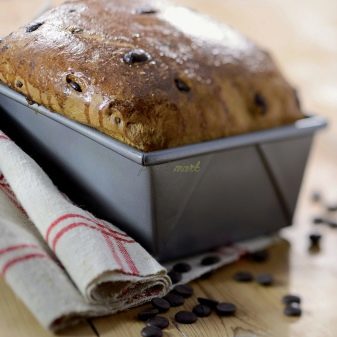
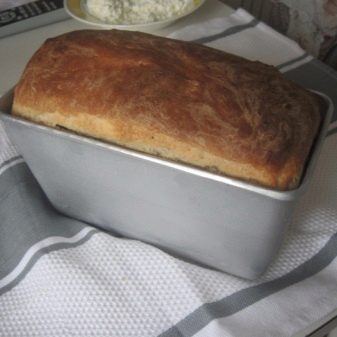
Clay
Traditionally in Russia, bread was baked in earthenware. For the manufacture of dishes for the oven or stove, only refractory chamotte clay is suitable.It can withstand heating temperatures up to + 1000– + 1100 ° С. There are such varieties of clay molds as:
- unglazed - the most capricious, require 5 calcination with oil;
- glazed - have a shiny surface;
- dairy - characterized by a brown tint.
In any case, before baking, the interior of the clay mold should be greased with butter or baking paper should be used.
According to the observations of professionals, if you fill a slightly heated form with dough, the dough will stick to it less.



Ceramics
Ceramic molds are distinguished by thick walls and a bottom, so they are able to retain heat for a long time. Rye bread, bakery products with fillings will be especially successful in this form. (seeds, herbs, spices). This dough rises slowly, so slow heating is very beneficial. To get tasty baking, it is recommended to pre-soak ceramic dishes in water for several hours, then moisture will fill the pores of the ceramic, and will evaporate when heated. The main thing is to wipe it dry thoroughly after soaking the mold. It is better to soak not before baking, but for a day.
Important! It is possible to wash a ceramic mold only after it has completely cooled down; it does not tolerate temperature extremes and washing in a dishwasher.


Glass
Experienced bakers do not like heat-resistant glass molds too much, which is due to its poor tolerance to temperature changes, the large weight of the container and its fragility. In general, glass containers are not the best option for baking bread, it will be poorly understood. You can also leave the container for the oven or microwave.

Silicone
Silicone is a material that is easy to maintain and use. The dough does not stick to the silicone surface, but it is impossible to heat the material above + 200– + 220 ° С. Sometimes this can be an obstacle to using such utensils for baking bread. Another important point is that silicone must be approved for use in the food industry.
Speaking of materials, you should also dwell on non-stick coatings. As a rule, they are found on products made of aluminum, cast iron and steel, that is, they are found on almost all types of baking dishes. If the product has a non-stick layer, you do not need to bake it. The non-stick coating can be ceramic, stone (usually marble) and Teflon. The latter is considered not the most suitable, since the maximum heating of the coating is + 200– + 240 ° С.


As for the shape, the most common are rectangular, oval and round. The first one is preferable because it is suitable for all types of ovens and ovens, and is ergonomic in storage. The edges of a rectangular container may be sharp or rounded. The latter are safer and more convenient, while sharp corners can cling to the elements of the oven, there is a risk of breaking them. Round pan-like shapes with low sides and domed lids are provided for hearth bread. Sometimes this shape is rectangular. Manufacturing material - cast iron, ceramics, clay.
The cover is needed to create a certain microclimate inside, reminiscent of the microclimate of a Russian stove. As a result, the bread rises well, it turns out fluffy and ruddy. For convenient removal of bread from the container, it makes sense to purchase an analogue with a removable tray. It can be removed separately from the tray to prevent the crust from sticking to the mold and crushing the bread when it is placed on the plate.
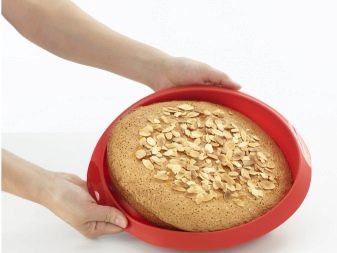
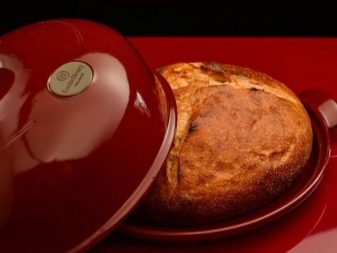
Review of popular models
It is worth noting well-known manufacturers and their models.
- One of the most famous brands - Kukmara. He produces a professional line of forms that comply with GOST. Users note that the bread bakes well, does not burn, and if you heat the mold, it literally pops out of it. On the bottom of such a form, the marking "L" must be put. This means that the mold is molded and has no seams.The letter designation is followed by a number - an indicator of the ratio of length, width and height of the form. In other words, according to the digital indicator, you can determine the size of the form and its capacity. These products are durable, suitable for daily use.
- The forms have also earned the trust of lovers-bakers from the Termico EcoCeramo brand. The name suggests that the material is ceramics. Indeed, the interior is made of this material. The outer one is a high-carbon steel, which ensures high-quality baking of bread. Thanks to the ceramic coating, a minimum amount is required to lubricate the mold, the bread can be easily removed from the mold. The optimal sizes are 28x15 cm and 28x7 cm. The container is presented in a convenient rectangular shape. Comfortable handles are also an obvious strength of the product. In addition, it is durable and attractive in appearance.
- If we talk about heat-resistant glass forms, then they deserve attention Simax products... Specifically for bread, there is the Classic line made of silicate glass. These forms are suitable for microwave ovens and ovens.
- There are glass molds for bread in the Pyrex range... The manufacturer uses borosilicate glass for its products. However, in any case, you should adhere to the rules for using glassware and remember that it does not tolerate sudden temperature changes.
- If you are looking for a silicone mold, then pay attention to the "rectangles" by Proflex Tefal... They have non-stick properties, convenient dimensions. In addition, the set comes with a stainless steel frame to make it easier to pour the dough and place the mold in the oven.
- Among the ceramic forms, French products are popular. brand Emile Henry... Thanks to innovative technologies, the cookware has a resistant glaze that can withstand the effects of open fire. Besides, it is suitable for gas stoves, microwave ovens.

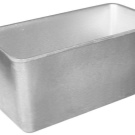




How to choose?
When choosing a bread pan, it is important to consider the type of oven. Almost all options are suitable for a gas oven - containers made of cast iron, ceramics, clay, aluminum, steel. Heat-resistant glass will turn out to be capricious. Similarly, a wide range of options will be for owners of electric ovens. Silicone and glass containers are recommended for microwave ovens. However, it is useful to know that real bread will turn out only if the microwave has a convection function.
For the Russian stove, you can use cast iron, clay, ceramic and aluminum (strictly from cast metal) molds. Silicone and glass will not withstand the high temperatures of a Russian oven.
When buying models with a non-stick coating, you should make sure that there is no damage or scratches on it. Be sure to inspect the dishes in bright light - darkening and unevenness indicate a low quality of the product.



Recommendations for use
After acquiring professional forms, they must be thoroughly washed with a detergent without abrasives, then wiped dry and put on a slow fire to ignite. In the process, oil residues will be released, which can be understood by a slight haze.that will stand out as the cookware heats up. As soon as a light smoke appears, you need to apply edible oil, for example, ordinary vegetable oil, to the walls and bottom from the inside of the mold. To do this, use homemade brushes - you need to fix a clean piece of foam rubber on a skewer. Store-bought silicone brushes will not work - they will melt.


You need to oil the mold for 3-5 minutes, continuing to keep it on fire. If it is hot enough, you will see that some of the oil is literally absorbed into the surface, filling the pores. The remaining oil can be drained off when it has cooled down. The form itself should be rinsed with hot water and wiped dry. In the future, it is recommended only to wash it with water, without using home chemicals for care.
When using glass products, it is important to avoid sudden temperature changes. Do not put such a product on a cold wire rack, wash immediately after cooking. All this can lead to cracks. After the mold is removed from the oven, it is placed on a wooden board with a clean towel wrapped around it.
You will learn how to bake a delicious baguette at home in the following video.








